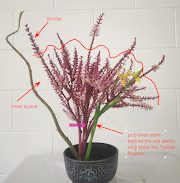Level 3.3: Line X Contrast (5 February 2022)
Always remember that you are aiming to go beyond simply designing an Ikebana work to create ikebana through meditation. Following the three-step learning model is recommended: start with a small aspect of design (Line X Contrast in this session), think deeply about all aspects of the design until new ideas emerge, and then follow the direction of your new ideas to find poetry in your work.
During this kind of creative meditation, it is hoped that you will learn to talk to the flowers rather than thinking about designs analytically.
In this session, 3.3. Line X Contrast, please use multiple line(s) and create contrast.
Contrast is the juxtaposition of different design elements, for example, dark and light values, or high and low density. Revisit what we learn about contrast in Contrast 1 & 2.
The following 4 points are very important.
1. In ikebana we may just say light and heavy, weak and strong or soft and hard. Such simple terms are enough to understand the basics of Ikebana Aesthetics.
2. Strong contrast emerges when the two elements are different but related.
3. High & low density is one of the most important types of contrast in Ikebana in order to create poetry.
4. Be aware of the purpose of contrast. It is not just to highlight the differences but also to create a focal point.
There are many strategies to create contrast using multiple lines. Please explore what appeals to you.
- Contrast between lines & mass: Line and mass are so different each other that you can create contest between them easily. Actually most traditional basic styles you learned at level 2 have such contrast. Considering above point 2, however, we are not practicing this strategy in this session.
- Contrast of density in the same (or similar) lines. Create high density area and low density area using similar lines, and emphasise a focus point. See our first sample in Contrast 1. This is a very useful strategy in ikebana, but if you use too many lines, you would end up with a massed form rather than multiple lines. Making a massed form using lines is a separate strategy we will learn in Form 3 in our curriculum.
- Contrast of strength in lines. In this strategy combine two different types of lines to create contrast. Consider above point 2 again, those lines are often related (they are both lines) and different (one is soft and the other is strong).
Another important point is to focus on only one type of contrast.
In Contrast 2, we mentioned that “If your work has high contrast in every element (colour, texture, tone, density etc.), your work may be ‘strong’ but may not be very poetic. Good ikebana works usually combine high contrast in one or two elements with low contrast in the other elements”. Learn how to control contrast - this is an advanced skill to learn at Level 3.
Objectives in Line x Contrast
- Find various lines in natural materials (stems, branches, vines, flowers etc). You can also create lines.
- Regard lines as “the bricks of a building”. Meditate on them. Combine them and create your design.
- Think about what kind of contrast you would like to bring out from your design of lines.
- Think how to emphasise the contrast you chose.
- See the video for some samples and learn some strategies. It shows you how to meditate on natural materials. Rather than copying the sample work, try to learn the meditative process. Our video analyses a couple of sample works. We hope that will be a starting point for your creative meditation.
- Check your work in terms of all other design principles, i.e., movement, contrast and pattern. You may not be able to apply all the principles but trying to incorporate some of them may help improve your work.
- Meditate on your work with your selfless mind, without thinking about designs. Make adjustments.
- In some Ikebana workshops, you may hear comments such as "you failed because you did not show contrast well." That is not our approach. We value design but we aim to go beyond design. In Level 3 our goal is to achieve harmony, which is higher than design in our definition.
What's Next? - Get Feedback
1. Book to join Zoom Ikebana Dojo by the deadline. That is the first step. Follow the instruction on the page.
2. After receiving confirmation of your booking, we send you links to access our video tutorial & our Zoom session. Our detailed video (members only) will help you analyse sample works, and help you make your Ikebana work.
3. Make you own work and send the image of your work to Zoom Ikebana Dojo (ikebana.dojo@gmail.com).
4. Join Zoom Ikebana Dojo. Enjoy friendly feedback from our facilitator and other participants.
5. Rework after the Zoom session.
6. Post your work to Ikebana Gallery Award.























